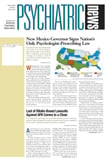What do the U.S. Chamber of Commerce and AFL-CIO have in common? Usually not much, but at the moment they are united by a common concern about the growing number of uninsured Americans.
Those national organizations, along with 10 others, released data in February showing that 2.2 million Americans lost their health insurance in the past year, on top of the more than 39 million who were uninsured as of 2000.
In his State of the Union address and subsequent speeches, President George W. Bush addressed the problem of the uninsured with an $89 billion proposal to use tax credits to help make private health insurance more affordable to those who have lost their jobs or who are otherwise not eligible for employer-sponsored insurance.
Under Bush’s proposal, eligible families with two or more children and incomes under $25,000 could receive up to $3,000 in credits to cover as much as 90 percent of the cost of purchasing health insurance.
The credit phases out at $60,000 for families and $30,000 for individuals. The credits are refundable, so their value does not depend on taxes owed. The credit could be issued in advance, rather than waiting until a family or an individual filed a tax return at the end of the year. Insurers would reduce the premium cost by the size of the family’s credit and be reimbursed by the federal government.
States would also have the option of letting certain tax credit recipients purchase coverage in their Medicaid or State Children’s Health Insurance Program (SCHIP) managed care plans, but there would be no requirement that states do so.
Barry F. Chaitin, M.D., chair of APA’s Council on Healthcare Systems and Financing, commented on the plan, “The president’s plan deserves serious consideration because it offers significant opportunities to expand coverage. However, the devil is in the details. We need to look at how issues of insurance availability and cost will affect people who need mental health services.”
At a hearing of the House Ways and Means Committee on February 13, Rep. Pete Stark (D-Calif.) called the plan “inadequate.” He added, “There’s no way we’re giving them decent coverage at a price they can afford,” according to a February 14 report on the Web site
kaisernetwork.org.
Ron Pollack, executive director of Families USA, said in a press release, “The individual tax credits proposed. . .are far too small to make health coverage affordable for low-income workers.”
In testimony submitted for the record at the February 13 hearing, Jonathan Gruber, a professor of public finance at the Massachusetts Institute of Technology, wrote that while Bush’s proposal would likely cover approximately 3.3 million uninsured people, an additional 1.4 million people would lose their insurance because it would lead employers to drop coverage.
On March 6 House Republican leaders took the tax-credit proposal out of a Republican-sponsored economic stimulus bill, which then passed the House on March 7, but the idea of tax credits to address the problem of the uninsured likely will resurface.
Last April a panel of policy analysts and insurance company representatives convened by the Center for Studying Health System Change identified potential problems with the use of this financing method.
According to the issue brief that resulted from the meeting, “Stand-Alone Health Insurance Tax Credits Aren’t Enough,” the panelists agreed that “the individual market’s major flaw is risk selection, or whether an insurer attracts a disproportionate number of sick or healthy people.”
Underwriting policies result in higher premiums for people who are older or sicker, if they are even offered coverage at all. Age alone can be a significant determinant of an individual’s premium cost in the individual market
Presenters at a meeting last August convened by the Alliance for Health Reform on “Making Tax Credits Work” offered details about the likely fate of insurance applicants on the open market.
Karen Pollitz, project director of Georgetown University’s Institute for Health Care Policy and Research, created seven hypothetical applicants with common problems such as allergies, a knee injury, depression, and high blood pressure combined with obesity.
Working with the National Association of Health Underwriters, she obtained 60 responses from insurance companies for each applicant (a total of 420). Pollitz found “enormous” variations in the premiums charged to each individual.
Many offers excluded conditions such as depression and allergies for which the individual would need treatment. Most offers were “substandard” in that they were priced at a higher rate than what was advertised or included fewer benefits.
Bob, the hypothetical applicant with a knee injury, received the most favorable offers, but even he was rejected 12 percent of the time and received substandard offers for 63 percent of his applications.
What Will Happen to MH Benefits?
With the help of Nicholas Meyers of APA’s Division of Government Relations, Pollitz created Emily, a hypothetical character with situational depression (
see box to learn how she fared on the open insurance market).
Deborah Chollet and Lori Achman, health analysts at Mathematica Policy Research Inc., examined the effectiveness of state-run, high-risk insurance pools.
In an August 2001 paper, “Insuring the Uninsurable,” they reported that the pools often charge premiums that are high relative to income, include sizeable deductibles and copayments, and restrict annual and lifetime benefits.
Although they are designed for people with serious or chronic illness, the pools “tend to impose preexisting-condition exclusions.” Some pools have long waiting lists, and one is closed to new applicants.
The pools typically limit coverage for mental health care, according to the authors. A chart showing mental health benefits for the 29 states with insurance pools shows such limitations as 50 percent copay, low ($25,000) lifetime maximums, and coverage only for inpatient days.
Chollet told Psychiatric News, “Tax credits will be of no use for those who want mental health benefits, unless they can find an insurance product to buy that will be affordable and will work for their needs.”
Howard Goldman, M.D., a psychiatrist and director of mental health policy studies at the University of Maryland School of Medicine, expressed a similar concern. “Tax credits could offer benefits to some of the healthier people who are uninsured. For many people, however, the help will mean moving from being uninsured for mental health to being underinsured for mental health.”
The Web address of kaisernetwork.org is http://kaisernetwork.org/. “How Accessible Is Individual Health Insurance for Consumers in Less-Than-Perfect Health?” is posted at www.kff.org. The Web address of the Center for Studying Health System Change is www.hschange.org. ▪

